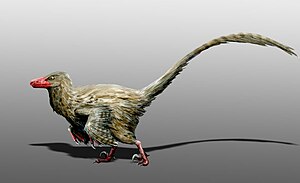Hesperonychus
| Hesperonychus | ||||||||||||
|---|---|---|---|---|---|---|---|---|---|---|---|---|

Drawing reconstruction of Hesperonychus |
||||||||||||
| Temporal occurrence | ||||||||||||
| Upper Cretaceous (late Campanium ) | ||||||||||||
| approx. 75 million years | ||||||||||||
| Locations | ||||||||||||
| Systematics | ||||||||||||
|
||||||||||||
| Scientific name | ||||||||||||
| Hesperonychus | ||||||||||||
| Longrich & Currie , 2009 | ||||||||||||
Hesperonychus is a genus of theropod dinosaur from the Upper Cretaceous (late Campanium ) of North America. This dromaeosaurid is currently the smallest carnivorous dinosaur known from North America.
Find history
The approximately 75 million year old fossil remains of Hesperonychus were found in 1982 in the Dinosaur Park Formation in Dinosaur Provincial Park in the Canadian province of Alberta . In 2007 the University of Calgary began to investigate the finds and in 2009 Nicholas Longrich and Philip J. Currie published the first description of the new genus with the only species ( type species ) Hesperonychus elizabethae .
features
The genus and species were first described on the basis of a pelvic girdle ( holotype UALVP 48778). Since the pelvic bones of the pubic bone (pubis) and the ilium had already grown together completely, they are the bones of a fully grown individual regardless of their small size. The weight of the animal is estimated at around 1.9 kg. This makes Hesperonychus the smallest non-avian theropod found in North America to date . When his prey are insects and small mammals and amphibians suspected.
Systematics
Hesperonychus is placed in the group of Microraptorinae , to which the four-winged Microraptor and the feathered dinosaur Sinornithosaurus , both of which belong, because of some similarities in the pelvic anatomy - including a lateral outgrowth of the pubic bone, a far back arch of the pubic community and a spoon-shaped pubic bone base of the much older Lower Cretaceous Jehol group in China are known.
A phylogenetic analysis showed no close relationship with the other North American dromaeosaurs. Instead, Hesperonychus is the first Microraptorinae found in North America, and by far the youngest member of this clade; he lived about 45 million years later than his East Asian relatives. Investigations of the fossil collections of the Dinosaur Park and the Oldman Formation (formerly combined to form the "Judith River Formation") uncovered many finds of individual bones of small, basal dromaeosaurids, which Longrich and Currie tentatively assigned to Hesperonychus . These findings show that these tiny dinosaurs were a significant part of the carnivore community of the Upper Cretaceous biota .
supporting documents
- Nicholas R. Longrich, Philip J. Currie : A microraptorine (Dinosauria – Dromaeosauridae) from the Late Cretaceous of North America. In: Proceedings of the National Academy of Sciences of the United States of America . Vol. 106, No. 13, 2009, pp. 5002-5007, doi: 10.1073 / pnas.0811664106 .
Individual evidence
- ↑ a b c Supporting Information (PDF; 296 kB) on: Longrich, Currie: A microraptorine (Dinosauria – Dromaeosauridae) from the Late Cretaceous of North America. 2009. Supporting Information 2. Specimen data.
Web links
- Smallest carnivorous dinosaur in North America (article in the Neue Zürcher Zeitung )